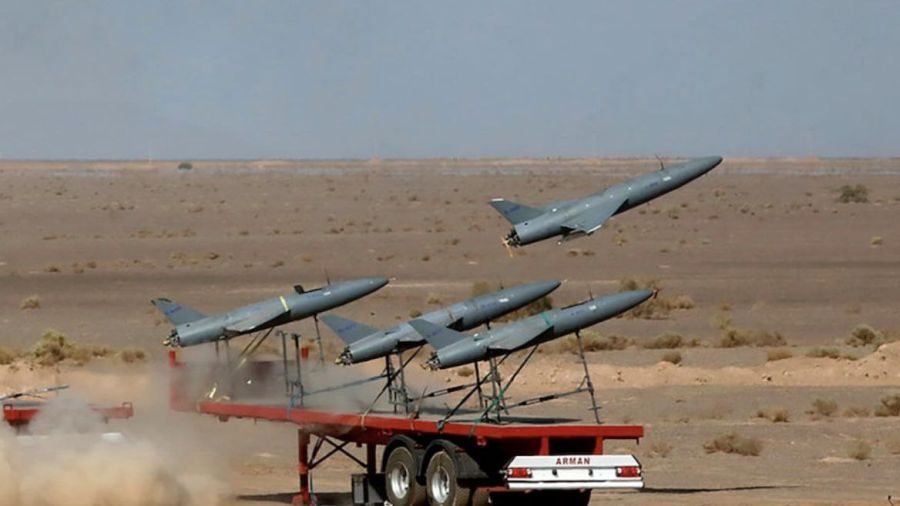Ukraine War Spills Over Into the Middle East
In spite of an overwhelming flood of disinformation coming from the Western mainstream media and governments, there continue to be obviously widely divergent views on the current war between Ukraine and Russia. The official and media supported narrative is that Moscow attacked its neighbor in violation of “rule based” principles of international relations, whereby an attack on any nation by a neighbor with the intent to seize territory is always and unambiguously wrong. That line of thinking, summed up in the media by the endlessly repeated phrase “Russia’s unprovoked war of aggression” has provided justification for the US/NATO intervention to support the Volodymyr Zelensky government’s effort to fight back against the Russians. It has also fed into the line that Ukraine and its supporters are standing up for “freedom,” “democracy” and even “good against evil.”
Flipping the argument to the Russian point of view, the Kremlin has argued that it has repeatedly sought to negotiate a settlement with Ukraine based on two fundamental issues that it claims threaten its own national security and identity. First is the failure of Ukraine to comply with the Minsk Accords of 2014-5 which conceded a large measure of autonomy to the Donbas region, an area indisputably inhabited by ethnic Russians, as is Crimea. Since that agreement however, Ukrainian militias and other armed elements have been using artillery to shell the Donbas, killing an estimated 15,000 mostly Russian residents. Second, Russia has balked at plans for NATO to offer membership to Ukraine, which would place a possibly superior hostile military alliance at its doorstep. Russian President Vladimir Putin has observed that the issues were both negotiable and that Zelensky only had to agree to maintain his country as “neutral,” i.e. not linked to any military alliance. Reportedly it was the United States and Britain that pushed Ukraine into rejecting any and all of the Russian demands in a bid to initiate a war of attrition using Ukrainian lives to destabilize Putin’s government and reduce its ability to oppose US and Western dominance.
There is considerable hypocrisy in the US/European point of view as the US and NATO have been invading and regime changing governments in a number of countries since 9/11, including that of Ukraine in 2014. Some critics of the fighting consider the Russian demands to be legitimate in that Putin has laid down very clear markers and is genuinely protective of his country’s security, though one might agree that it is a step too far to embrace any armed attack by one country on another unless there is a clear and imminent threat. But in this case, the escalating involvement of the US and NATO in the fighting is an extremely dangerous development because it could easily escalate the conflict and turn it into what might become a devastating nuclear exchange. One would like to see a truce initiated to stop the fighting right now followed by serious negotiations to come to a settlement of the territorial dispute. But, of course, the United States, which has provided Zelensky with more than $100 billion in aid, has made it clear that it is not interested in a negotiated settlement unless Putin is willing as a confidence building first step to surrender all occupied Ukrainian territory, including Crimea. In other words, he must surrender.
Concerns that the fighting in Ukraine might somehow involve more players and could become regional and even grow beyond that point seem to be borne out by the content of a New York Times article that appeared recently. It is entitled U.S. Scrambles to Stop Iran From Providing Drones for Russia and subtitled “As the war in Ukraine grinds on, some officials have become convinced that Iran and Russia are building a new alliance of convenience.” Now bear in mind that anything appearing in a major American news outlet is likely to be a placement or leak by the US government itself. The Times sources the report to “…interviews in the United States, Europe and the Middle East, a range of intelligence, military and national security officials [who] have described an expanding US program that aims to choke off Iran’s ability to manufacture the drones, make it harder for the Russians to launch the unmanned ‘kamikaze’ aircraft and — if all else fails — to provide the Ukrainians with the defenses necessary to shoot them out of the sky.”
All of that means that the sources of the information are unnamed and should be consider anonymous and therefore not verifiable, but the article is intriguing nevertheless. Its lead paragraph states “The Biden administration has embarked on a broad effort to halt Iran’s ability to produce and deliver drones to Russia for use in the war in Ukraine, an endeavor that has echoes of its yearslong program to cut off Tehran’s access to nuclear technology.”
So, it would appear that the proxy war against Russia has now entered the Middle East, more specifically Iran, where the United States and Israel have long engaged in assassinations of scientists and technicians as well as sabotage of facilities and introduction of cyberattack “worms” (Stuxnet) into computer operating systems at research facilities. Indeed, the article states that Israel and the US have been engaging in discussions regarding exactly how to proceed in targeting the Iranian drone production. On December 22nd, a secure video meeting took place between Israel’s top national security, military and intelligence officials and Jake Sullivan, the Biden Administration’s national security adviser. The participants “discussed Iran’s growing military relationship with Russia, including the transfer of weapons the Kremlin is deploying against Ukraine, targeting its civilian infrastructure and Russia’s provision of military technology to Iran in return.”
There certainly is a large measure of hypocrisy clearly evident in Washington’s efforts to stop Iran’s sale of weapons to Russia while the US is simultaneously giving many billions of dollars-worth of weapons to Ukraine. Initial US efforts to reduce the alleged impact of the drones on the battlefield have up until now focused on blocking the sale or distribution of the non-Iranian produced technology that goes into the construction of the drones. The US military has, as well, provided Ukraine with intelligence that would enable counter-strikes on the Russian launch sites. But these efforts have only been partially successful as the electronic components being used are widely available or can be adapted employing “dual use” components if one source of supply is cut off. Also, those crafty Russians have apparently learned to change launch sites frequently as the drones and the trucks they are mounted on are very mobile.
But the Times article raises more questions than it answers. For example, it appears that the Iranians have sold to the Russians something like 1,700 drones and as of mid-December an estimated 300 of them have been used, hardly a game changer in the type of fighting taking place in Ukraine, particularly as their use in a so-called kamikaze role means that they strike their target detonating an explosive attached to the drone. That means they are destroyed in one use. And there have also been reports of supply chain problems, so it is not clear how many of the drones have actually been delivered. And the Russians certainly have their own drone factories as part of their highly sophisticated arms industry, so it is not like they were desperate for assistance from Iran in spite of claims to that effect in the US media.
To be sure, Iran has an active drone program and Iranian drones have been used in attacks directed against US military bases in Syria as well as against Saudi Arabian refineries. The “Shahed” drones are cheap and simple but effective and it is believed that Iran can mass produce them, if necessary, as long as it can continue to obtain the necessary components. It might be said that they constitute a “poor man’s” choice of weapon to use against much more powerful and sophisticated enemies like the United States or Israel.
Be that as it may, there is something that makes no sense about the Biden Administration’s sudden desire to take on Iran in a more active way, with Israel as a partner, using the Ukraine war and Russia as an excuse. Biden and Secretary of State Antony Blinken have walked away from renewing the Joint Comprehensive Plan of Action (JCPOA) nuclear monitoring agreement with Iran even though Tehran was prepared to make concessions and it is in the US national security interest to have such an agreement in place. Newly reinstalled Israeli Prime Minister Benjamin Netanyahu has already addressed the powerful American Israel Public Affairs Committee (AIPAC) and called for a “close alignment” with Washington to work aggressively against Iran. A series of meetings between Israeli and US intelligence and national security personnel are now scheduled to be held in January. And, of course, the Biden State Department and National Security agencies are full of advocates for a hard line vis-à-vis Iran, Russia and now even China. Most of them are also outspoken Zionists, many with close ties to Benjamin Netanyahu, which makes them partial to Israeli interests.
Iran, which does not actually threaten either the US or any identifiable strategic interests of Washington, is already on the receiving end of virtually every sanction imaginable put in place over more than forty years by successive American presidents. And now, because Iran is friendly with Russia and supplying that country with weapons that are surely welcome but unlikely to change the course of the war, the US is again preparing to make and take on yet another enemy, possibly with Israeli clandestine or even open help. One wonders nevertheless how much of the posturing by the White House is real and how much of it is fake. Since the United States is now approaching a $1 trillion defense budget for 2023, somebody has to figure out a way to both justify the expenditure while also making all that money politically useful by telling the public that the spending is making Americans “safe.” And what could be better than using all those shiny new weapons on a few “enemies” here and there, guaranteeing that the defense contractors will get even richer and will kick back even more to the very politicians who are the source of the largesse. Could it all be as simple as that?







